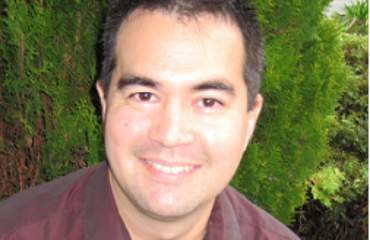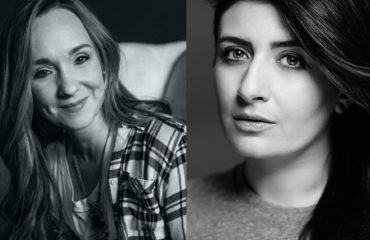INTERVIEW WITH Raegen Pietrucha

FWR: To start, I was hoping you might speak about the pull of Greek mythology, both in its use as a framing device for some of the poems and a source of imagery in others.
RP: When I drafted my first poem about Medusa way back in 2007, it was about a different subject entirely. My mother had survived breast cancer and been in remission ever since her double mastectomy, but I’d come to realize that something significant had changed in both the way some men perceived and treated her (and women like her), as well as the way she perceived herself. Something about that recalled to my mind the mythic woman with snakes for hair, that body transformed into something so terrifying that it also physically petrified anyone who looked upon it.
But as I delved deeper into the myth — or the myriad variations of the myth — I moved away from that idea and toward what, to me, is the real crux of Medusa’s story: She is a woman who, in many versions of the myth, is raped by Poseidon on the altar of Athena; then, as if that wasn’t heinous enough, she is transformed into a monster. And this is the story of so many women (and others, not just women) to this day. That realization was too powerful and potent to ignore.
And there were a lot of directions I could’ve gone in telling any story of survivorship. I suppose I could’ve just stuck to a contemporary story or set of stories; I could’ve also written it in prose, but poetry specifically allowed me to bridge important gaps between fiction and nonfiction in a way that felt natural, seamless, and protective because poetry can be both and neither of those things — fiction and nonfiction — at the same time. But to me, there’s something very powerful about pointing back to something so old, because it effectively allows me to say, “Look! Look at how much time has passed, and look at how this still has not changed. That’s not OK.” Something as old as Greek myth allows you to do that. Another thing about the myth, specific to Medusa, is that the story of her becoming a monster in so many versions quite literally relies on that singular act of sexual violence at the hands of Poseidon. Before that, without that, she is portrayed as an average woman — beautiful, perhaps, but a physical form we’d recognize.
But because most mythology (Greek or otherwise) also comes with its own set of images — symbols — which seem to be more fantastical to us in today’s world because they are so far from our lived experience— it is a rich trove from which to draw imagery and metaphor. While you can reinterpret the meaning of that imagery, as I did often throughout the book, a lot of it was more or less handed to me as part of the original story, from the snakes to the ocean to the stone — all of which, it seemed to me, related very specifically to sexual assault survivorship. And with any luck, in Head of a Gorgon, I’ve built out those ways in which I saw the myth’s imagery and the subject of survivorship connecting.
FWR: I was intrigued by starting Head of a Gorgon with the Flash Forward section and “The Gorgon’s Parting Thoughts”, which, to me, created a structural ouroboros. How did you decide on the structure of the manuscript?
RP: I love that concept: a “structural ouroboros”! That’s an awesome way of describing it! I’m stealing that!
The reason we flash forward to an end at the beginning is twofold. One, I was taking a feminist theory course in grad school while working on my thesis, which was how the concept for Head of a Gorgon started, and one of the things we discussed is the experience of time as it relates to gendered experience and society. Some suggest women’s experience of time is more cyclical — think menstrual cycles and the like — whereas men’s might be considered more linear — and here I think we can infer what the reference would be to in that case. I wanted both, especially since, in some versions of the Medusa myth, she actually represents the circle of life (birth, death, and rebirth), but this writer exists in a patriarchy.
The other aspect relates to the title and what is actually going on overall in the book. That moment when Medusa “dies” right at the beginning is the opening up of her head, from which this entire story is able to pour. In some versions of the original myth, when Medusa is beheaded, Pegasus and Chrysaor fly out. It’s quite a stretch to consider the book itself Pegasus or Chrysaor, but the idea of something having to end, in order to begin again and/or get to the core of its meaning made sense to me in the framework of this version of the myth.
FWR: Building off the idea of the ouroboros, I thought the use of repetition was powerful, particularly in the return of the “Your Captain Speaking” poems. Upon my first read of the first instance of a poem titled this, I was struck by how the poem pointed to voice and power structures: “who cares what other stories have told you? /… Who retains the right to name?”. Repetition returns later, with both secrets kept and new relationships reminiscent of old. Could you talk about what drew you to repetition?
RP: There is so much related to survivorship that reinforces, that ruminates, that obsesses. It can be very cyclical in quite literal ways: Being sexually assaulted at a young age, for instance, puts victims at a higher risk for being victimized again in the future. The physical experience could have ended, but the survivor’s mind can replay it over and over (i.e., PTSD). It can, in many ways, become all-consuming. So repetition is essential, to me, in portraying some fundamental aspects of the experience of survivorship.
Specifically with respect to the three “Your Captain Speaking” poems, originally, those three poems had different titles when they were first published. But at some point, as the collection really started solidifying, it seemed to me that those three poems in particular, which were always similar in tone, were more or less coming from the same sort of persona, and it was someone I didn’t want to specifically name because I wanted to leave that open to the reader’s interpretation. But how could I still signal to the reader that these three poems are from the same persona just like poems from the perspective of “P” are all Poseidon and the capital-“S” Snake is also a singular persona?
I happen to be a huge Louise Glück fan — her poem “Mock Orange” was transformational for me as a writer — and she actually has three poems interspersed throughout her collection The Seven Ages that are all titled “Fable.” So I thought, “Well, maybe that device can work here, too.” In that sense, the title of those three poems in Head of a Gorgon is a bit of an homage as well.
FWR: Another form of repetition were the “Shedding Skin” poems, which are erasures of poems that appear earlier in the manuscript. Can you talk about the development of these poems?
RP: If repetition is symbolic of what traps a survivor, then strikethroughs/erasures/rewriting can be considered symbolic of freeing oneself of that cycle, or at the very least creating something new. But there was something early on for me with this collection that called to me to recognize that the change and escape needed to be physically represented on the page, and erasure — making something new and empowering from something that had once been used against the self — was a physical, visual, tangible way of accomplishing that.
FWR: One of the poems that first jumped out at me was “Sex Ed,” which I thought both played with the reveal of information, on a multitude of levels, and struck me as an exploration of innocence and loss, particularly the lines “naming things commands / nothing”.
I’ve been thinking about the Teju Cole essay “Death in a Browser Tab” recently and how artists can make sense of violence (in its many facets) without emphasizing the act, but rather the human experience of it. How did you balance the tension between naming the act of violence (and violation) and centering the person experiencing it?
RP: Did I balance the tension? I’m not sure I know, because that wasn’t something I specifically set out to do. And I think that’s because it’s my belief that there’s no amount of telling someone what a certain experience feels like that will make them actually experience the thing. Words themselves are symbols — like how maybe one way we can think of Rene Magritte’s “The treachery of images (This is not a pipe)” is that he is directly acknowledging that an image of a pipe is not the same as having an actual, 3D pipe in one’s hand.
So even in the Cole essay you referenced, for example, the viewing of another’s death doesn’t give the viewer the experience of personally dying, nor does it provide them with the experience of someone killing, nor does it even provide the experience of witnessing such events firsthand; it provides only the experience — still undoubtedly traumatic, still undoubtedly tragic — of witnessing those types of things at a distance, on a screen. But the viewer is feeling a set of feelings that may or may not be similar to any of the other three real-life experiences not actually experienced by the viewer.
I very much hesitate to say that artists “make sense” of violence or any other thing, for that matter — at least to anyone besides the artist themself. But having the belief that no amount of explaining or describing any act is going to make someone who hasn’t personally lived through it experience it firsthand or understand that experience as someone who has lived through it — and even two people experiencing, say, the same violent act will experience it differently, though there’s more common ground between the two — leaves a writer with the option instead to create some other type of experience that the writer (if the writer is like me) hopes draws toward something maybe approaching a universal truth, if there can even be such a thing, out of a real or imagined experience.
With respect to a poem like “Sex Ed” specifically, I simply set out to give voice to a woman, Medusa, who is sidelined and silenced in most tellings of her own story. And there are certainly other interpretations of this voice and story based on who’s doing the telling. We need common terms to refer to in this case — sexual abuse, assault, rape — so that people have some sense of general foundation of what’s being discussed. But from there, words are just a different experience than those actual physical, real-life experiences entirely. This is where words — and for me, any art form — will always fail. Still, I do believe in the power of words — some power in them — because look at the harm they can also cause. It’s not a physical violence, per se, but it is a violence nevertheless.
Is this all confusing, contradictory, paradoxical? I suppose. But it’s still all also true, at least to me.
FWR: I was also drawn to the poem “Cheer”, which spoke to ideas of power and heroism, as the speaker details “hoping the right / words paired with the right actions will someday / help me take some form of flight.” I read “Note From the Nadir” as a response to this childhood optimism, as the speaker wrestles with the fact that “no savior awaits”; now “I know the hero I sought will never reach me, doesn’t exist.” Instead, “my head still ingested what was fed. / What can you do when part of the problem is you?” Assuming I’m not off base (and I very well may be), can you speak to how you developed the conversations between the poems, and overall emotional arc of the book? Thinking of heroism and the head of the gorgon, how does the story of Medusa and Perseus fit?
RP: When you work on something for a decade-plus, you probably have too much time to think about it, but I tried in many ways to build as much meaning as I could — as many layers as possible — into this work. There are a lot of Easter eggs. What you’re referring to here — the conversations among the various poems — was very much considered and deliberate. This is easier to do when you have a narrative arc and are kind of building a shorter version of a novel in verse — perhaps a novella in verse. This is where my original background in fiction came into play. So I took the pieces I had, which were from Medusa’s adulthood and I thought of the parts, then, that were necessarily missing, like a childhood. And I started building some threads, images, terms that would be common among them and would evolve through the book.
Just like any person, there is change along the way; there is devolution, evolution, or both. The arc for my Medusa is devolution, to a kind of death, to a necessary evolution in order to survive — a mirroring of the birth/death/rebirth cycle that Medusa represents in some versions of the myth but that’s really all tied to the feminine in general (e.g., Mother Nature). Some of these concepts were drawn from the myth; others were drawn from survivorship. But all really echo the idea that each of us needs to become our own hero; Medusa, for me, is no exception to this rule. I tend to believe that it’s when we look outward for saviors that we are in the most danger. And I say this as a spiritual person, but one who acknowledges the truth of my personal experiences and understands that the universe requires action on one’s own behalf — like “The Drowning Man” story — in order to find one’s personal, true salvation.
FWR: What are other poems, or who are the poets, that you turned to as guide posts in the creation and construction of your poems?
RP: This book would not exist at all without Larissa Szporluk, who even beyond being my mentor and advisor is the brightest light I know in the poetry world with respect to understanding to the core that literally every story anyone ever tells is myth — and delivers that message to us constantly through her work and her teaching. Louise Glück, whom I mentioned earlier, is my top influence as far as voice is concerned; the authority of voice in her work was definitely something I strived toward in Head of a Gorgon. Anne Carson’s Autobiography of Red would be a close second with respect to this collection in particular, from the mythic aspects to the narrative arc to the play with form.
Jason Shinder’s work also influenced my collection. His work feels at times as if it were written in a vacuum; he seemed to know what he needed to express was important and created a world unto itself in which the way he spoke was the only way that would’ve made sense and was therefore the best way. I wanted to create this Medusa’s world in a vacuum. I wanted the bulk of Head of a Gorgon to feel isolating, inescapable, suffocating, because this is what I imagine Medusa’s experiences in the first few sections of the book feel like.
Others of note include Marie Howe; she does an impeccable job of what you were pointing to in your fifth question with respect to speaking on the experience of survivorship. She just calls a thing a thing with such directness and clarity, yet also such beauty. Sharon Olds’ writing on all things feminine and domestic helped me to ground my work in the everyday, ordinary things of contemporary life as I transported this ancient myth into modern times. The political in Adrienne Rich’s work, of course, is essential. Monique Wittig’s Les Guerilleres, whose nonlinearity is inspiring. Virginia Woolf’s Orlando and Joanna Russ’ The Female Man for their explorations of gender. Sylvia Plath and Anne Sexton for their sharp words. And William Shakespeare for his deep dive into form but also making form feel more conversational, less form-y by the standards of his time — another thing I strived toward in my collection.
–
Raegen Pietrucha writes, edits, and consults creatively and professionally. Head of a Gorgon is her debut poetry collection. Her poetry chapbook, An Animal I Can’t Name, won the 2015 Two of Cups Press competition, and she has a memoir in progress. She received her MFA from Bowling Green State University, where she was an assistant editor for Mid-American Review. Her work has been published in Cimarron Review, Puerto del Sol, and other journals. Connect with her at raegenmp.wordpress.com and on Twitter @freeradicalrp.







